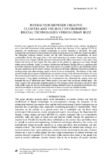| dc.contributor.author | Aktan, S. | |
| dc.date.accessioned | 2022-10-07T14:07:39Z | |
| dc.date.available | 2022-10-07T14:07:39Z | |
| dc.date.issued | 2021 | |
| dc.identifier.issn | 1746-448X | |
| dc.identifier.uri | https://dspace.yasar.edu.tr/handle/20.500.12742/18599 | |
| dc.description.abstract | Creative class supports the local urban development process with their social, cultural, and physical acts in the built environment while promoting the urban buzz. Because of the ongoing COVID-19 pandemic, the involvement of digital technologies in creative industries is inevitable. The study compares the conventional working model and online working process to clarify how digital turn affects the interaction between creative clusters and the built environment in consideration of social sustainability. Firstly, this paper looks at the social interactions in creative clusters, and investigates how creative class engages with the physical environment in the office environment. It also takes a step further and focuses on how digital turn takes place in this pattern by applying a case study through online surveys in Izmir, Turkey. It contains Architecture and Interior Design firms as a significant part of creative industries located in Izmir. The online survey was applied in order to get information about the space preferences of the creative clusters, and figure out the major differences between conventional working model and online working model in terms of social sustainability. The findings of this study provide insight about impacts of digitalization on creative clusters in the urban environments. It is seen that environmental behaviors of the creative class have direct effects on the process of the local urban development. Using digital technologies for communication has eliminated the surprise factor and damaged the use of urban-buzz areas where creative class meet their social and cultural needs. This study suggests that, during this adaptation period to the changing model, precautions should be taken in the earlier stages for the city development. Finding alternative ways to cooperate with creative class should be developed to keep the urban buzz alive in terms of social and cultural activities. | en_US |
| dc.language.iso | English | en_US |
| dc.publisher | WITPress | en_US |
| dc.rights | info:eu-repo/semantics/openAccess | en_US |
| dc.subject | Creative class | en_US |
| dc.subject | Creative clusters | en_US |
| dc.subject | Digital technologies | en_US |
| dc.subject | Environmental behaviors | en_US |
| dc.title | Interactıon Between Creative Clusters And The Built Environment: Digital Technologies Versus Urban Buzz | en_US |
| dc.type | Article | en_US |
| dc.relation.journal | WIT Transactions on Ecology and the Environment | en_US |
| dc.identifier.doi | 10.2495/SC210061 | en_US |
| dc.contributor.department | Department of Interior Architecture&Environmental Design | en_US |
| dc.identifier.startpage | 61 | en_US |
| dc.identifier.endpage | 72 | en_US |
| dc.identifier.volume | 253 | en_US |
| dc.identifier.scopus | https://www.scopus.com/record/display.uri?eid=2-s2.0-85121832817&origin=SingleRecordEmailAlert&dgcid=raven_sc_search_en_us_email&txGid=c1e620ba0909a0a6a13cc69fccc3da43 | en_US |
| dc.contributor.yasarauthor | 0000-0002-2866-1914: Selin Aktaş | en_US |















